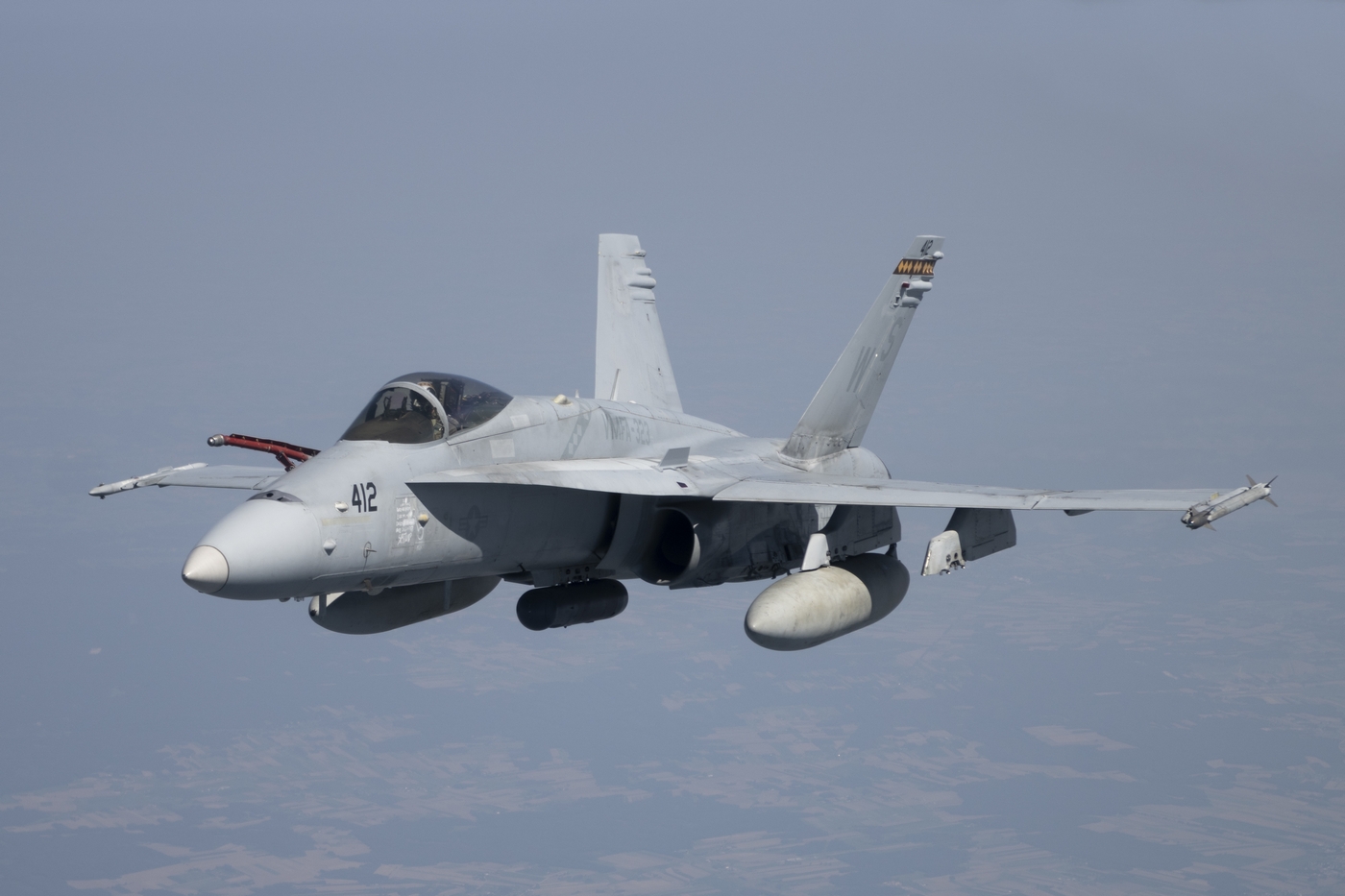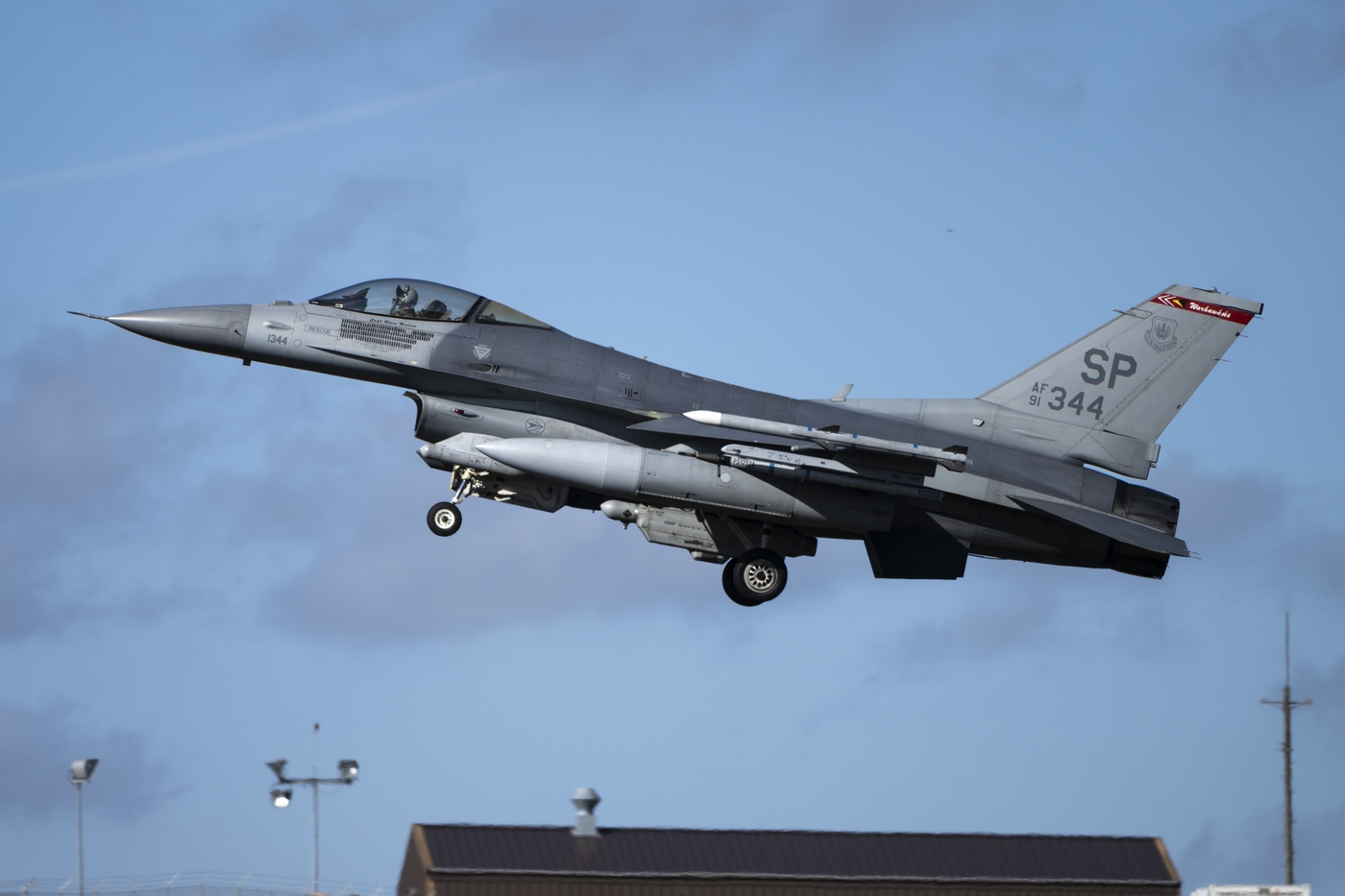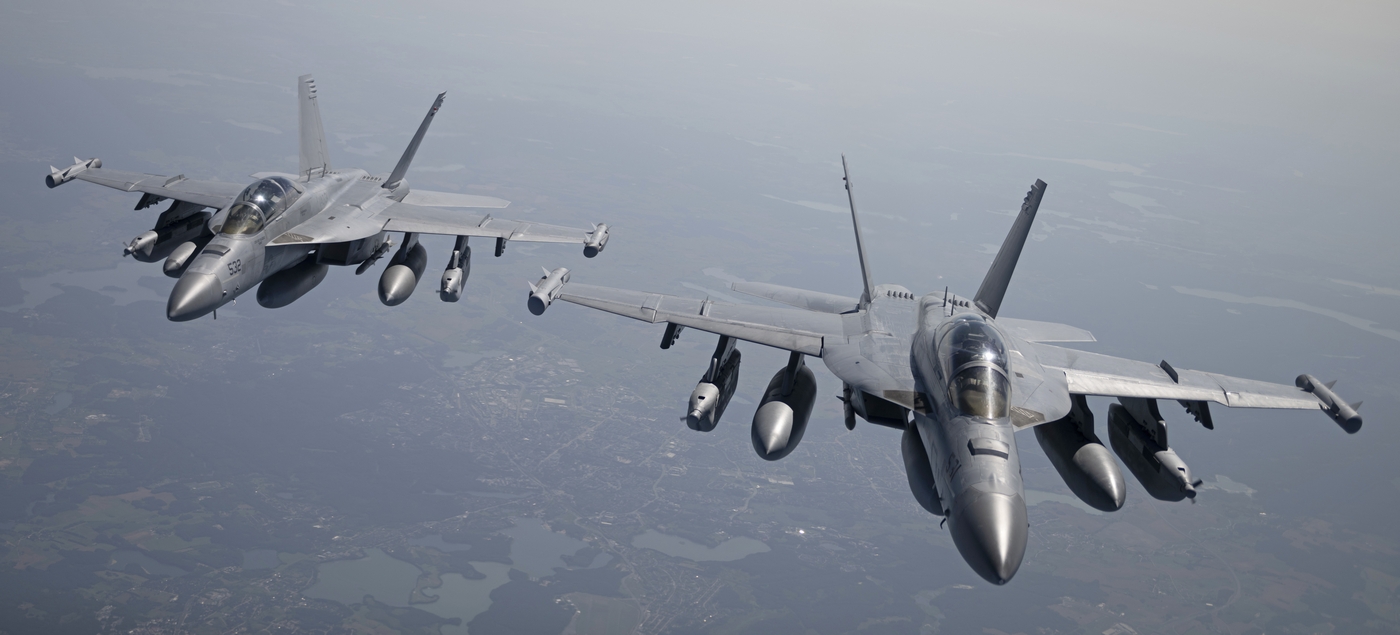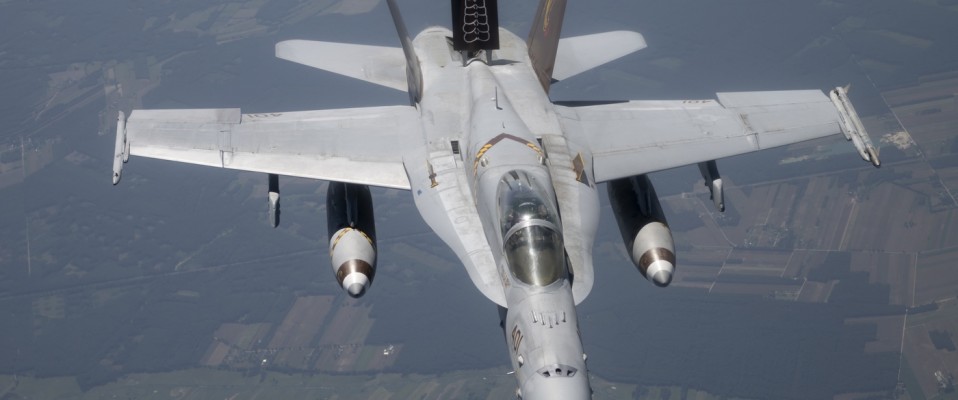VAQ-134: Risk Reduction Management
Report and photos by: Patrick Roegies, Ben Gorski & Jurgen van Toor
December 5, 2022
Introduction
On 28 March 2022, six Boeing EA-18G Growlers assigned to Naval Expeditionary Squadron VAQ-134 “Garudas” deployed to Spangdahlem Air Base with the purpose of bolstering readiness, enhancing NATO’s collective defensive posture and further increasing air integration capabilities with allied and partner nations. The squadron has since been operating to support the European mission and has been working with the U.S. Air Force and NATO Forces with the purpose of adding Electronic Warfare capability training with the United States Air Forces in Europe (USAFE) counterparts and NATO allied nations. The EA-18Gs have been operating continuously and are also involved in operational missions throughout the weekend. Patrick Roegies, Ben Gorski and Jurgen van Toor visited Spangdahlem Air Base to assess the experiences and lessons learned throughout the six-month deployment.
Vision and mission
With the Ukrainian conflict starting on 24 February 2022, the United States administration decided to bolster the capacity and capabilities in Europe by means of temporary deployments.
Recently during a NATO summit In June, United States President Joe Biden highlighted the intention to assign two Lockheed Martin F-35A squadrons to RAF Lakenheath as a part of his administration’s response to Russia’s invasion of Ukraine. Once those two squadrons have acquired their operational status the United States government has no short-term plans to further expand its fifth-generation fighter capacity in Europe, the new commander of United States Air Forces in Europe (USAFE) Gen. James B. Hecker communicated in a recent published interview.
In this same interview, however, he commented that the fifth-generation fighter capacity in Europe will be bolstered in the near future. On the short-term planning, in addition to the two Lakenheath squadrons, Hecker stated USAFE will continue to get help from F-35 squadrons stationed in the United States.
The United States Air Force deployed three units to Spangdahlem Air Base with the purpose to provide that additional support for the Department of Defense as well as NATO allies and partners: KC-135 Stratotankers, F-35 Lightning IIs and U.S Navy EA-18G Growlers. This initiative started on 16 February 2022 when twelve F-35As from the 34th Fighter Squadron based at Hill Air Force Base, Utah deployed to Spangdahlem Air Base in Germany. Eight F-35As were replaced by the 158th Fighter Wing/134th Fighter Squadron Vermont Air National Guard arriving on 02 May 2022. On 3 August this deployment came to an end when the aircraft returned home to the USA. A Dozen Lockheed Martin F-22A Raptor assigned to the 90th Fighter Squadron, Elmendorf Air Force Base Alaska arrived in Europe early August and took up Lask Air Base, Poland as their temporary home for the near future. Besides the aforementioned temporary deployments, Spangdahlem Air Base also hosted another United States Air Force / Air National Guard deployments. The first was a deployment of three 60 & 305th Air Mobility Wing KC-10As in the second half of May. These were replaced by KC-135R assigned to the 92nd Air Refueling Wing.
The temporary deployment of the EA-18G Growlers assigned to Electronic Attack Squadron VAQ-134 “Garudas” is a short-term solution to add electronic warfare capability with the purpose to be able to project a multi-disciplinary force that has all the required capabilities to operate in case the conflict escalates.
The primary mission of VAQ-134 “Garudas” is to conduct sustained airborne tactical electronic combat. As an expeditionary squadron, the “Garudas” have been trained and have the capacity to deploy worldwide to support U.S. Air Force expeditionary wings, allied/coalition task forces, Marine aircraft groups, and U.S. Navy strike groups.
The Boeing EA-18 Growlers assigned to VAQ-134 “Garudas” specialize in flying electronic warfare missions using a wide variety of jammers to confuse the adversary radar systems, significantly adding to the ability to conduct suppression of the adversary’s air defense operations.

Organizational structure
LCDR James “Homeskool” Corrin explains; “The EA-18G Growler joint expeditionary squadrons are not under the auspices of the Navy expeditionary Combat Command (NECC). The five operational Navy EA-18G Growler expeditionary squadrons are subordinated under the command of COMVAQWINGPAC at NAS Whidbey Island, and Captain David F. Harris our Commodore. He is responsible for the Joint Expeditionary Squadrons from a ‘man-train-equip’ perspective. And then tactically, we are farmed out to whoever is going to direct these squadrons in a given theater. So out here ultimately in Europe, EUCOM will direct the expeditionary squadron and our actions from a tactical perspective”.
LCDR James “Homeskool” Corrin further explains that “The Secretary of Defense, following the recommendations of the Joint Chiefs, put out the request for the Expeditionary Squadrons to deploy, and then orders to deploy were executed. In the case of VAQ-134, we received the orders to deploy to Europe with about a 96-hour notice”.
Getting started
Russel Oster, Deputy Director, 52nd Mission Support Group, based at Spangdahlem Air Base commented, “The preparations for the temporary deployment of VAQ-134 “Garudas” went very smoothly,” and he commented he experienced the cooperation with the Naval Expeditionary Squadron as very professional. Spangdahlem Air Base is unique as it is geographically and strategically positioned, ideal for hosting temporary deployments as it has excess capacity for operations, maintenance, and infrastructure like dorms.
He continued, “This part of preparing the deployment is not as exciting as the flying part, but providing everybody the opportunity to [eat], rest, access government networks, available mission planning space, and receiving the deployed unit’s equipment are very important basic requirements that will determine the effectiveness of the deployment. Although 96 hours was a short preparation time and a bit of a surge it is to the Navy’s credit that they send an advanced team of five persons with the right sort of functional skills to support with the logistic preparations”.
LCDR James “Homeskool” Corrin, who was a part of the advanced team, further explained the preparations for the deployment. “We received the first message that it was likely that a possible deployment to Europe would take place on short notice. So as soon as that word got out, we got boots on the ground to build relationships, because it is all about the relationships. We were able to get to know each other from a face-to-face meeting instead of just calling in the middle of night and starting the preparations in a chaotic way.”
He continued, “Instead of going through, ‘Who are you, and why are you going to be here?’ the hosting operational support squadron representatives already knew us, and basic arrangements had been prepared. So then we’re just making more of minor adjustments, like for instance our dining facility schedule. In the meantime, we’re trying to figure out the operational requirements to meet the flying schedule and what it means for the maintenance schedule. In this pre-deployment phase, it is all about getting on the same page to ensure the basic requirements are fulfilled as well as the operational requirement are met.”
“Homeskool” added to this comment “once the order to deploy was issued, all necessary arrangements were rapidly prepared to ensure the best possible transition for both the personnel and the aircraft. Lodging needed to be arranged as well as a squadron ready room, but also a special section of the airbase needed to be assigned to the squadron to shelter and maintain their aircraft. I experienced the support provided by the 52nd Operational Support Squadron as very professional. For example, they transformed their meeting room into an operational gear space for us to use. They gave us access to computers, made sure we had an operational and maintenance area, and ensured our team had a place to sleep and were fed. We had to use the Air Force network to gain computer access, which is different from the Navy network, and we all received the correct accounts to be able to access their systems.”
Setting up the provisions for the maintenance of the aircraft was not arranged by the 52nd OSS. Given the duration for the deployment additional requirements needed to be arranged. Besides the first line maintenance performed by the squadrons VAQ-134 “Garudas” also needed to make provision to perform their intermediate level maintenance referred to as Van Operation Detachment (VOD), in order to keep their aircraft operational for the entire duration of the deployment.
Purpose & necessity
Essentially, when the Air Force withdrew the EF-111 from operational use, there was a perceived gap in capability that this platform provided. As there was no suitable successor, the Air Force coordinated the electronic warfare capability with the help of the assets assigned to the United States Naval Aviation. Within this coordinated approach the electronic warfare assets assigned to the Naval Aviation provide the support to the United States Air Force. This was the genesis of the idea of the formation of the Joint Air Expeditionary Squadrons.
“Homeskool” is the tactical training and admin officer of VAQ-134. He explains that risk reduction is the most important aspect of training to the aircrew in the squadron and the main reason why the squadron is temporarily deployed to Europe. He further explains; “This is what I’m teaching my guys every day. We’re all about managing risk. We assess wherever the current risk level is for the mission, and we decrease that risk level to meet the commander’s acceptable level of risk. We want the EA-18G Growler to be there in order to reduce the overall risk to the mission and risk to force as we degrade threat weapons systems and eliminate or reduce their capability to harm us.”
He continues; “As an EA-18G Growler, we uniquely fit into the escort, SEAD, and strike gameplan. Historically, the EA-18G Growler was considered a high-value asset aircraft, and it required strike fighter squadrons (VFA) to ensure a safe operational environment for us. This mentality has shifted, however, over the past decade, where we now use proper planning and placement inside of an integral mission to keep us both lethal and survivable while supporting our designated protected entities.”
A different mindset
“From many perspectives,” LCDR Corrin continues, “there is no difference in working with Naval Aviation assets and Air Force assets. Most of our systems are designed in an integrated manner. The Department of Defense (DoD) networks are all designed that way from the start. The Joint aircraft are all able to communicate with each other and exchange information. Coordination can, and often will, occur over the UHF/VHF radios all military aircraft carry on board. We can use our voicecom, datalinks, or other means to communicate as long as they are built properly in the existing network. We have been working with E-3 AWACS, the 480th Fighter Squadron F-16s, the temporary deployed F-35s and several NATO partners. It’s all about the networks and people. So there is no difference, from that perspective, of working within a Naval Aviation environment or in an Air Force environment.”
“This communication is critical, as modern tactics demand coordination between all the various assets in order to properly manage risk and achieve the mission requirements. These tactics are established in joint doctrine and practiced during exercises. As threat capabilities have advanced, this has understandably forced the US and its allies to shift gears and modify the way we do things, adapting to new scenarios and rethinking our approach to various problem sets. Everybody, including the Navy, is learning that nobody can do anything well by themselves. It’s all about the joint force. It’s about working with your allies. And it’s about the cohesion of everybody being able to work together. In the middle of that is the EA-18G, whose aircrew has to understand and mitigate unique risk to each different platform. That results in Growler aircrew having a broad understanding of each aircraft and nation’s strengths and weaknesses, which is a unique perspective that we bring as an expeditionary squadron”.
Force synergy
“Non-kinetic effects, such as those from Electronic Attack aircraft, are a critical component to a commander’s desire to reduce risk to mission and risk to force. That requirement might be fulfilled by a EA-18G Growler, or an EC-130H Compass Call, or in the future an EC-37B. The biggest advantage of the EA-18G Growler compared to the Air Force equivalent aircraft are its numbers, the fighter-based platform, and its rapid availability. There is no niche aircraft or system in the Air Force right now that does everything we do, nor will there be for some time”.
Compared to the Air Force equivalents the EC-130H and the EC-37B, the EA-18G can operate closer to the fight. A unique capability of the EA-18G Growler is that it has all the required weapons onboard to act as a fighter aircraft. “We have the ability to carry HARM missiles, jamming pods, and air-to-air missiles that, combined, allow the Growler to operate on the frontlines. Alternatively, the EC-130H has to operate a little further behind the lines, and forces have to be postured appropriately to protect the high value and limited asset. An EA-18G Growler can also go significantly faster than an EC-130H, which allows the Growler to get into the fight and then get rapidly out of the fight as the situation requires. So, I wouldn’t ask the question “What is the Air Force equivalent capability?” as there are no directly competing platforms. It’s much more about the synergy of all the different capabilities coming together. And that’s how it really has to work in the modern conflict; the electromagnetic spectrum is massive.”
“So, no, the EA-18G Growler is not going to win the fight for you alone, as there’s no single asset that’s going to make that happen. It’s about bringing them all together, especially when we look at the major competitive countries that are out there.”
“One of the biggest parts of having been a weapons school instructor, and then being the tactics instructor in my squadron now, is that we work hard to prevent making any scenarios that anybody can win by themselves. Not only would this be unrealistic, but our students are not going to learn much by just figuring out how to solve a problem alone. It’s about forcing people to work together, and forcing people to talk, get on the phone and figure out how to use their capabilities together to make it actually work”.
Although, the Air Force still has not developed a suitable dedicated aircraft to fulfil the Electronic Warfare role after the withdrawal of the EF-111. The Naval Aviation command recently opened the discussion if the Joint expeditionary Squadrons should remain operational. The Air Force currently operates the EC-130H Compass Call. The EC-130 brings many capabilities for executing electronic warfare, but it is not as effective in many mission sets as the EA-18G Growler due to its design, availability, and jamming pods. As discussed, there are several alternatives to expand the electronic warfare capabilities across the Air Force fleet. The Air Force is currently developing the EC-37B, which is replacing the Compass Call in the future. So that is another capability that will be added to the non-kinetic style fight.
The Marine Corps also operates a number of expeditionary squadrons. At this moment VMFA-323 Death rattlers has deployed ten F/A-18C Legacy Hornets to the European continent as well. However, the Marine Corps expeditionary concept is very different from the Naval expeditionary concept. The main difference is that Naval Expeditionary Squadrons are deployed to support other units that have been deployed, whereas often the Marine Corps, their expeditionary mindset is different. Going back to the history of World War II, they’re a very awesome and capable force that is able to internally support itself for expeditionary operations.
The Marines Corps expeditionary units, either operating from the minimum level that’s going out there or whatever level it is, their air assets are supporting their ground assets are being supported by their artillery assets, and they are a very self-contained unit. Alternatively, an EA-18G Growler Expeditionary Squadron cannot often accomplish any mission directly. They are there to enable the other participants to execute their missions at a lower risk and with a higher chance of success. That is the main difference, and that’s the capabilities they provide to any mission commander.
Cooperating with the Air Force
So what makes the naval expeditionary squadron unique according to “Homeskool”? “I would say that we are specialized in working with the Air Force and the Joint Force as a whole. During our deployment workup cycle, our command will go through multiple large force exercises working with the Air Force and our allies. For example, prior to this deployment we participated in two Red Flag exercise across Nevada and Alaska as well as Northern Edge. During those exercises we worked with numerous U.S. Air Force assets preparing for deployment as well as joint partners such as the Australian Air Force and the Singapore Air Force. All of these exercises are about bringing people together to learn how to fight safely and cohesively. These exercises allow us the unique ability to practice with our joint partners in preparation for working with them across the world on their turf. Many in our command also have previous experience working with a Carrier Air Wing, bringing additional knowledge to the fight.”

“Certainly, there is a big difference between operating within a Carrier Air Wing and operating in an Air Force command structure with land-based assets. The one thing the aircraft carrier is always focused on is safely launching from and recovering to the aircraft carrier. A big part of your mission is always landing on that ship. Having sufficient gas to do so in an efficient and organized manner is critical. And this is something naval carrier-based aviation is astutely professional at accomplishing.”
“Because we operate from land bases, we don’t have as critical of fuel constraints as an aircraft carrier would that is concerned with recovering one jet at a time every 45 to 60 seconds. That provides us some unique opportunities. We also have the ability to accomplish significantly more planning with all the other assets, since we’re not limited by the capabilities of the ship’s networks.”
Sharing experiences
“Homeskool” reflects on the experiences gained throughout their deployment. “During our deployment we have been afforded the opportunity to train with the 480th Fighter Squadron F-16CMs that specialize in the Suppression of Enemy Air Defenses (SEAD) role. The integral cooperation between the Electronic Warfare EA-18G and the Wild Weasel F-16s is a synergistic mixture of capabilities that we wanted to gain as much experience with while deployed to Spangdahlem Air Base.”
The Air Force is very experienced with working with the EA-18G Growler and integrating them into their tactics. Prior to joining VAQ-134, I taught at the Naval Aviation Warfare Development Center teaching Growler tactics. We would send assets to Nellis twice a year to participate in the Air Force Weapons School Integration (WSINT) phase of training.

Lessons learned
“I would say the biggest lesson learned regarding deploying to Europe is the logistical coordination and the significance of planned military infrastructure,” said “Homeskool”. “Getting everyone fed and housed is critical to sustained operations. Additionally, the importance of open communication between all the various training officers and all the different NATO countries is critical. Networking among various countries and platform Weapons School officers was significant to creating valuable training exercises across the continent. It’s all about the networks and the people.”
“Homeskool” concluded, “The reality is the United States, the U.S Air Force, and the U.S Navy don’t fight alone, nor do we deter alone. Our global network of alliances, partnerships, and joint warfighters is a key strategic advantage. Our mutual resolve to defend every inch of NATO territory has absolutely strengthened our network of regional Allies and partners to accelerate the development of cutting-edge capabilities, new operational concepts, and international cooperation in space has never been more important.
Patrick Roegies is born and raised in Tilburg, the Netherlands and currently resides in Sittard in the south of the Netherlands where he lives with his wife Joyce. Patrick graduated from a technical study at the HTS in Tilburg in 1997. He currently works as a head of an equipment engineering department in the south of the Netherlands.
His passion towards aviation started at the age of 7 in 1977 when his father took him to nearby Gilze Rijen Air Force base where he witnessed his first howling F-104 Starfighters which were practicing and as a result he got addicted immediately. The F-104’s were present in order to determine a tactic to create a diversion for the “train highjack” which was going on in the Netherlands at that time. The F-104’s were meant to create a diversion by performing an overshoot, kicking in the afterburner directly over the train, creating confusion with the hijackers and enabling the police to master the hijackers. This action has actually been performed and worked.
This is when his passion towards aviation was born. He got permission from his parents to visit the airbase every free hour he had and his father showed him the way by bicycle. Patrick got his first camera in 1984 which was a Canon T50 and shot Kodachrome 64 slides of mainly military aircraft. He changed his gear in the mid-nineties to Nikon and is a Nikon user ever since.
When Patrick obtained his driver license in 1989 he started to visit airbases all over Europe and from 1997 onwards he made worldwide visits to military airbases.
In order to further professionalize his work as an aviation photographer and journalist he started to write military aviation related articles based upon his visits to various nations and their Air Forces. He managed to publish his first article in 2003 and increased the numbers of publications every year.
Patrick can be reached at: [email protected]

